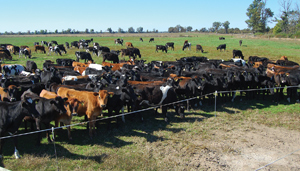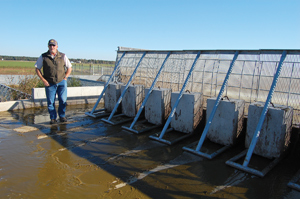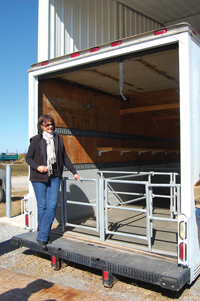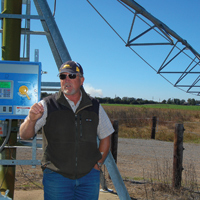Peter Gaul and family are making a go of it on the second try
Benton, Missouri — It was April 2008. The midwestern heavens were unleashing torrents in record volumes, and Peter Gaul’s newly constructed dairy barn in the Bootheel of southeastern Missouri had become an island in the flooded Mississippi River. Hundreds of acres of recently seeded pasture were underwater for 35 days. Easy access to water may have been a primary reason Peter and his family moved to this locale from New Zealand to graze dairy cows, but this was a bit much.
Way too much. The flood, along with the ensuing dairy crash of ‘09, brought an abrupt end to an investor-owned venture that was dealing with a host of other problems. When the foreclosure came, the Gauls lost their entire investment and had to scramble to stay afloat. They made plans to concede defeat and head home, where Peter had developed a well-respected demonstration dairy at Lincoln University. Just another Kiwi who learned the hard lesson that the U.S. is an entirely different grazing world.
Five years on, Peter and his wife, Jo, are still in Missouri, and son Frankie is the day-to-day manager of an 840-cow grazing dairy atop soils that conventional U.S. producers might judge to be better suited for freestall bedding. On virtually pure sand where a tree farm had failed — and in a locale where dairy hasn’t been done in years — the Gauls say they are making solid progress in their attempt to meld New Zealand grazing and business philosophies with the realities of a tough climate and a grazing support system that is nothing like what was available back home.
“We’ve sort of risen from the ashes here,” Peter describes.
Even with a better location and committed financial backing, Tribute Farm remains a work in progress. Peter acknowledges that his pastures are not where they need to be, and he’s not certain of where he’ll end up in terms of forage species and grazing management. The Gauls are still learning the proper levels of stocking, supplemental feeding and equipment ownership. Even something as basic as determining the best season for calving remains a work in progress for a dairy that must deal with both extreme summer heat and scanty winter forage growth.

Peter acknowledges that like other Kiwis who had successfully figured out grass dairy in their homeland, he’s had to learn the hard way that U.S. conditions require different tactics — most of which involve investment and herd averages well beyond the norms for even modern NZ operating models.
Says Peter, “We’re the ones who have to make the changes. What we knew was useful, but it’s what we didn’t know that is more important to our success here.”
A diverse career
His career in New Zealand was both diverse and successful. Peter and Jo sharemilked for several years, Peter worked in extension, and he was a founding partner in a private consulting firm. He earned an animal science degree from Lincoln University, later joining the faculty in its farm management department. There, he played a lead role in developing the use of electronic plate meters for measuring pasture dry matter. As part of an industry alliance, he developed Lincoln’s demonstration dairy, building a 700-cow, profit-focused operation that provides information about best management practices for the South Island’s irrigated dairies.
Meanwhile, Peter was becoming intrigued by the idea of milking cows in the U.S. About a decade ago, a few of New Zealand’s more successful dairy farmers started seeing the U.S., with its relatively low land prices and good milk market, as a land of opportunity. Investor groups — many including individuals from other countries — were formed to buy land and start grass-based ventures. Missouri in particular was promoting itself as the place to be.
Peter was looking for a move, he was attracted to the idea of developing a commercial dairy, and he knew people willing to back such a venture. He wanted a farm where cows could be grazed almost every day of the year. While other investor groups targeting Missouri were buying up land and building milking facilities in the southwestern portion of the state, Peter looked elsewhere, making nine trips to the U.S. to scout properties. He and his backers settled on a piece of land in the far southeastern portion of Missouri, not far from the Mississippi but beyond the river’s historic floodplain.
Peter wanted water — water that could be brought to the surface with little effort and pumped through pivots to keep pastures green and growing through the summer. He had seen how irrigation transformed the sheep and croplands of New Zealand’s dry South Island into productive dairy pastures, and he wanted the kind of water supply that would produce a similar miracle in the U.S.
“I won’t farm without irrigation, and this is one of the strongest aquifers in the world,” he says. “There are few silver bullets in farming, but irrigation is definitely one of them! Irrigation will be essential to the future of the dairy industry.”
Yet there were problems right away. Hundreds of heifers were purchased near the peak of a strong market. Peter wanted lighter soils to avoid mud and compaction problems, but the chosen property had some clay.
The investor group proved unwieldy. “It had too many foreign investors, each with a different viewpoint,” Peter describes. He says the dairy could have been converted to a quasi-confinement operation, but the principals couldn’t agree on how to proceed.
Of course the historic flood, which covered 80% of the acreage just before a scheduled first cutting, created huge problems in terms of milk production and feed costs. And the financial meltdown of 2008-2009 proved fatal for a venture that couldn’t agree on how to proceed. The bank foreclosed, and the Gauls were in tough financial shape.
“We paid a heavy price,” Peter describes.
But he didn’t give up on the dream. Peter knew that his model could work with the right investors backing him on the right piece of land. He felt local investors were needed to allow him the flexibility to adapt to local conditions. But months into the effort the search wasn’t going well, and the Gauls made preparations to leave for New Zealand.
Then, the right person came to the fore. Peter is reluctant to talk about his financial backer, saying only that he owns a manufacturing enterprise and that his business acumen has been an asset to the venture. And while operating funds have also been made available during the start-up, “He is not a sugar daddy,” Peter insists. “I am accountable for every cost.” With solid backing, in January 2010 Peter set about establishing a new dairy on a different piece of property — one that won’t flood before the next ark is needed.
A lot of sand and trees
The $1,700/acre purchase price was just the beginning of the spending to convert this property to dairy grazing. Many graziers wouldn’t even attempt the task, as the 678 acres purchased, along with 470 leased acres across a road, are virtually pure sand.
The property had once grazed beef and grown crops, but for the 14 previous years had been planted to 320,000 pulp trees. That business failed despite attempts (Peter says they were poor attempts) at irrigation, and the place was basically one big swath of scrubby trees. The nearest large animal veterinarian is 60 miles distant.
Yet there were advantages here, too. The rolling dune topography allows up to seven of the 48 paddocks on the main farm to be employed as wet weather sacrifice areas. “There is not a stone on the place,” Peter adds. “And you won’t get stuck on these soils.”
Mainly, there is water to be had: Peter says the water table under most of the farm is relatively stable at just eight feet below the soil surface. Electric surface pumps (40 h.p.) provide plenty of water to the pivots, which are usually programmed to deliver an average of a third of an inch of water each day at just 30-35 p.s.i. of pressure. The monthly electric bill for each quarter-section pivot averages near $1,500 when the system is being run full tilt. “It is very cheap to reach and apply water here,” he notes.
Six center pivots capable of covering 85% of the Tribute Farm property were installed on the main farm where the cows are milked. Two additional pivots cover 65% of the leased ground where dry stock are grazed. Total cost: $600/acre. Another $600/acre was spent during the five months required to remove the trees. More than $200,000 was spent on cattle lanes and equipment roads, and many additional thousands went toward fencing and paddock water.
A 54-bail, New Zealand-built (Milfos) rotary parlor was sited on a high spot near the middle of the main property — a place that also fits snugly between the areas covered by the irrigation pivots. Peter says the tall sides and a giant ceiling fan have done a good job of keeping the parlor facility cool.
Peter knew he needed to keep cows cool in this climate, and also that he did not want to compromise pasture irrigation by attempting to do all of that cooling under the pivots. So a steel 210-by-166 foot shade barn with feeding lanes was sited at the end of the covered holding area that is attached to the parlor building. With 16-foot open sidewalls and a 25-inch ridge top vent, Peter says the cows stay comfortable there during hot summer afternoons.
The barn is flushed with a gravity flow system using plate cooler water stored in tanks — no scraping or hosing has been needed. This water is pumped to an unusual solids separation unit that has no moving parts. Placed on a constructed sand mound, the “weeping wall” employs gravity and steel mesh to separate solids in two, side-by-side holding areas.

Separated fluids flow to a lagoon, from which they are pumped through two of the center pivots. Thus far the lagoon water has not plugged the pivots’ conventional nozzles. The solids in one of the holding areas are allowed to dry while the other one is doing the separating.
Three or four times a year, movable steel filter panels at the front are removed using a front-end loader. Solids are composted with sawdust before being applied to the fields. Total cost for the weeping wall was just over $120,000.
While the recent spell of cold weather has been challenging for the separator and showed a need for some minor design adjustments, overall the system has worked very well. “To date it’s worked like a dream,” Peter says. “We think it’s a reasonably low cost and sustainable design.”
Two sheds were built and a line of equipment purchased. Tribute Farm grew corn over most of the property in 2010, sending 1,050 purchased yearling heifers off the property for grazing.
After 14 months and more than $10 million in purchase and development money, the first of those heifers freshened in early 2011. Peter says the project could have been done for a bit less, but he’s happy with the emphasis on quality that went into its building.
Alternative soil fertility
That’s a lot of money to invest in what amounts to a big pile of sand that started with organic matter levels at 2% and lower. But Peter likes where he’s at. “This free-draining sand, it’s just fantastic,” he says. “It’s a wonderful soil from a structural standpoint. You can change soil fertility very quickly, which means you can build it quickly and also lose it quickly.”
He’s shifting away from the traditional NPK fertility mindset and is working with alternative soils consultant Neil Kinsey. “I think historically we’ve oversimplified fertilizer,” Peter explains. Urea as a lone application has been dropped from the program, with sulfur and trace minerals added in small amounts as necessary based on grid sampling and an overall nutrient balancing and budgeting program. He’s running fertility trials under three of the main farm’s pivots, leaving the fourth as a control area.
“We never found a worm on this place until this year. Now they’re here,” Peter reports.
Passionate about grasses
Forage production as measured by electronic plate meters (says Peter, “I wouldn’t farm without a plate meter”) has averaged about 6.5 tons dry matter/acre. The goal here is to have milking cows grazing at least some of their feed needs every day of the year.
To this point the milking herd forage ration has been up to 100% pasture from mid-March through late June, with grazing accounting for upwards of 85% of the total feed ration. Pasture as a percentage of total forage scales back to 60-70% into September. By November, grazing is down to 25% of the forage diet and the pastures (both perennial forages and grazed cereals) are metered out so that the relatively small number of cows milked through the winter consume 10-15% of their forage ration from pasture during the three months when pasture growth is halted.
Even with nearly 900 cows calved last year, along with feeding 180 yearling heifers and 240 heifer calves, Peter says the farm is almost self-contained when it comes to forage. More than 4,000 round bales of ryegrass or millet baleage are made each year and 105 acres of corn silage were grown and stored in bunkers last year. Commodity feeds such as dried distillers, hominy and soyhulls, along with some fescue and alfalfa bales for early spring supplementation, are about all that is being bought onto the farm these days.
Like some other Kiwis who’ve moved to the U.S., Peter has become convinced that the “big weather” he’s encountered here requires a more conservative line of thinking in regard to feed reserves. “We’re learning that we need to carry a bigger inventory,” he notes. The general drift here is toward having more feed on hand, which means more land devoted to harvested crops.
That does not mean that Tribute Farm is going to abandon pasture. “I’m just passionate about grasses,” Peter asserts. It’s just that he’s still trying to figure out which grasses will work best over the long run here. The corn silage is needed to help him through a series of re-seeding experiments, and his plan is to grow less (and buy more) of it as pastures develop and herd numbers grow.
New Zealand’s staple perennial ryegrass-white clover combo works very well here in spring, early summer and early fall. “Nothing beats ryegrass and white clover for four or five months here,” he reports.
Searching for answers
It’s the rest of the year that needs quite a bit of work from the forage side. He’s been using novel endophyte BarOptima fescue/white clover and annual ryegrasses for additional spring and fall yields. Bermudagrass has been tried in the summer, but Peter does not particularly care for it given that other grasses have more to offer under irrigation.
Instead he’s been trying some annuals such as BMR grazing sorghums, sudangrasses and millets that also yield relatively high-quality harvested forage. Peter also wants to see if alfalfa might offer some summer production under the pivots. For winter, annual ryegrass has worked well, and so have turnips and rape.
Not all of this works as smoothly as advertised. Hot summers limit the cool season grasses, and white clover tends to eventually dominate under the pivots. Peter has tried occasionally spraying it out to avoid yield losses, and he is also doing some ryegrass and fescue seeding without clover. Low-quality crabgrass volunteers into the swards during the summer months — a problem that has yet to be solved. And in general, for better or worse “the fescue is winning out” over the ryegrass, he reports. “We’re going to be stuck with doing a lot of drilling for a while to strengthen the permanent pastures,” Peter laments.
The cow herd is making good progress from the base of Holstein and Jersey and Holstein-Jersey cross heifers Peter bought in late 2009 (at much lower prices than he had to pay in starting the first farm). By year-end 2013, 40% of the herd was split evenly between pure Jersey and pure Holstein and the remainder was almost entirely Holstein-Jersey crosses.
With an eye toward future value-added milk sales, Tribute Farm has been breeding with A2A2 genetics from LIC. He sees American genetics also being employed to boost milk production, and Peter is also trying a little Normande.
Cows are synchronized, and up to 250 are bred in the rotary parlor during a single day. The great majority of breeding has been timed for first freshening at the end of January.
But Peter is starting to think that fall calving — or at least a split season with fall calving numbers being virtually equal to those of spring — may be the way to go.
“I never thought I’d say that,” he acknowledges. But keeping cows comfortable and productive in the summer has been a real challenge. “It is easier on animals in the winter,” Peter notes. He foresees moving open cows from spring to fall freshening, thus saving on replacement needs.
Also evolving are his views toward production per cow. While Peter always knew he’d need to feed cows and attain a decent herd average, his concept of such is moving into a higher range with the passing years due to relatively high overhead costs. “We’ve got to lift milk volume both through cow numbers and production per cow,” he explains. “That’s a different view from when we started. We thought just cow numbers would do the job.”

Cow numbers are indeed going to rise, with Peter seeing a split-season herd approaching 1,500 cows as a potential target. The herd average has been steadily increasing, from about 11,500 lbs. in 2011, to 13,900 lbs. last year. Total milk shipped rose from 7.6 million lbs. to 10.5 million lbs. over that period. Son Frankie leads a team that includes seven other permanent staff, plus seasonal help. Jo is in charge of the calf program along with biosecurity, mastitis management and milk quality.
Peter’s calculations indicate that “non-grazed” feed has increased from 27% of total dry matter intake in 2011, to 36% last year. “We may end up 50-50,” he says. “It’s going to take us a while to figure out the most profitable level.”
Hopefully such efforts will result in greater success than the Gauls’ first dairy venture. The family’s financial goals include starting to purchase the farm. To do this, they will need to a double-digit return on investment (excluding capital gains).
Non-financial goals include sharing information with the U.S. dairy grazing community and being a good neighbor in the local community.
Gratitude
The farm’s name reflects his gratitude toward getting a second chance here. “It is a tribute to God’s provision in seeing us through difficult times, and to the people who worked together to make this happen,” he explains. “We’re just grateful for the support and encouragement of the people who have helped us.”
Peter says that the family, which also includes younger son Josh, is committed to their new home: “We want to stay here. We’re excited. This thing will work.”

